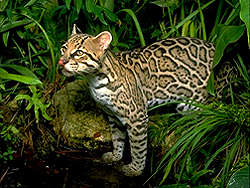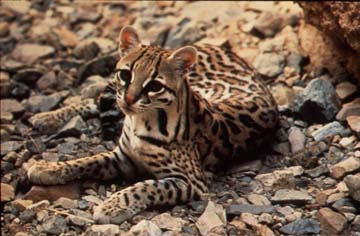The Last of the Ocelots in the United StatesWHETHER IT BE THE SMALL BLACK BEAR POPULATION IN NEW JERSEY OR THE MINUTE AND "HANGING-ON - BY-A-THREAD" OCELOT POPULATION OF SOUTH TEXAS, EDUCATION, FUNDING FOR ADDITIONAL OPEN SPACE AND BASIC HUMANITY IS REQUIRED FOR THE GREAT DIVERSITY OF LARGE AND MESO- CARNIVORES TO PERSIST THROUGH THIS 21ST CENTURY AND ON INTO THE FUTURE..................... CHECK OUT THE OCELOT INFORMATION BELOW.................... In a small corner of the Lower Rio Grande Valley of Texas, the last of the wild ocelots in the United Statescling to life. North America, Central America, and much of South America, today the ocelot has almost disappeared from its range in the southern United States, and subspecies of the ocelot are threatened by the conversion of large areas of its natural habitat into farm land, and by the growth of cities. It is estimated that as few as 80-100 wild ocelots survive in the United States today -- most, if not all of them within the Laguna Atascosa Wildlife Refuge, in the eastern part of Cameron County, near the town of Bayview, Texas.  These sleek, furtive, These sleek, furtive, finely-tuned cats, silent and seldom seen by humans, are nocturnal, spending their days resting in brush so thick that the only way a person can move through it is by crawling on their hands and knees. And if you've ever been to the Lower Rio Grande Valley of , you know that you don't want to do that. It has been said of this area that if it doesn't sting you, stick you, or bite you, it ain't from around here. People may find the habitat inhospitable but wildlife love it. The problem is that the remaining habitat sits atop land that is valuable for agriculture. Once a land of sabal palms and thornbrush, much of the Rio Grande Valley today is stripped of vegetation Female ocelots prepare dens for their kittens in thick, thorny, low brush, such as spiny hackberry, lotebrush, and blackbrush. Mothers leave at night to hunt, but spend each day with their kittens (usually 1-2 per year) at the den. The kittens begin hunting with their mother when they are about 3 months old, but remain partially dependent upon her until they are about a year old. Females begin breeding when they are about 3 years old, and typically have only one kitten per litter. Although thought to survive only 5-6 years in the wild, they've been known to live into their twenties in captivity. Offspring tend to remain with their mothers for a little more than a year, then disperse to new territories. In general, as with other cats, territories are clearly marked by urine. Solitary, the male defends his territory from other males.  The time The time when a young male goes off on his own is the riskiest period of a male ocelot's life. He must either find an unoccupied territory or be strong enough to take control from another male in a vicious, often fatal, battle. With the encroachment of civilization, there are other dangers too. In search of habitable land, the ocelot is prone to being struck by cars while crossing roads. The lack of suitable habitat is the most significant barrier to a young male finding a territory of its own. There is nowhere to go. Outside of the Laguna Atascosa Wildlife Refuge, all but 5% of the region's landscape has been altered, and unlike the bobcat, the ocelot has shown itself unable to adapt. The refuge is the perfect habitat for the ocelot, but most of the land around it is settled, or in use as agricultural property. The Laguna Atascosa Wildlife Refuge is surrounded by salt water on one side, and by farms and rangeland on the others. Few remaining corridors connect the refuge with other suitable habitats, and those that do cross roads and highways. The motor vehicle has become the ocelot's primary enemy. It is estimated that 2% of its ocelot population is lost on the roads that pass through the refuge. It gets worse. The State of Texas is scheduled to improve two of the roads that lead through the refuge, to create a two-lane highway that would shorten the trip from the Harlingen airport to South Padre Island by about 10 miles, an event that would result in more traffic traveling at higher speeds, a recipe for disaster for the ocelot population in the United States.  In 1999, In 1999, Congress approved a plan for the acquisition of enough land to more than double the size of the refuge by buying and acquiring easements on more than a hundred acres of farmland over the next 20 years, restoring it to its natural state. However, at this writing, the United States Senate has not yet released these funds. They are needed. The optimum territory for single ocelot is 500 acres. Some Laguna Atascosa males have only 80, while the youngest have none. North of the refuge, Frank Yturria, one of the Lower Rio Grande Valley's largest landowners, has chosen to sign a perpetual conservation easement for 600 acres of his property. Although he will continue to own the property, he has agreed to leave it in its natural state of dense, thorny brush. It is believed that from 5-10 ocelots have found their way to this new refuge. Unfortunately, others are killed in traffic before they reach it. Although biologists are working with the Texas Department of Transportation in the hope of developing road crossings for ocelots, little real progress has been made. The highway department tried building culverts beneath the roads, but the ocelots refused to use them. Larger, perhaps more viable structures, may prove to be expensive. |
Subscribe via email to get updates
Friday, May 28, 2010
A WAKEUP CALL FOR THE OCELOT--ONE OF THE RAREST CATS IN NORTH AMERICA
Subscribe to:
Post Comments (Atom)










No comments:
Post a Comment